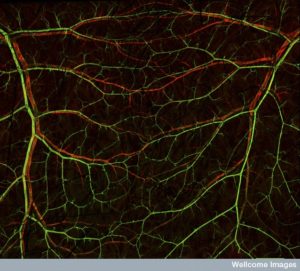 It is well known that neurons send a variety of intelligent critical signals to other neurons, glia, and immune cells using neurotransmitters, vesicles of several types, cytokines and nanotubes between cells. Elaborate back and forth communication between immune cells uses a wide variety of cytokines, neurotransmitters and vesicles with genetic material. Recently, intelligent decision-making by many other cells was discovered, including epithelial cells lining the intestine and skin. Choroid plexus cells determine every molecule that enters the brain’s cerebral spinal fluid. They, also, call for very specific help from particular immune cells for any problem throughout the brain including identifying where where the trouble is in the brain. Even the lowly platelet, not really a full cell, has vital decision-making capacity through complex back and forth communication with immune cells.
It is well known that neurons send a variety of intelligent critical signals to other neurons, glia, and immune cells using neurotransmitters, vesicles of several types, cytokines and nanotubes between cells. Elaborate back and forth communication between immune cells uses a wide variety of cytokines, neurotransmitters and vesicles with genetic material. Recently, intelligent decision-making by many other cells was discovered, including epithelial cells lining the intestine and skin. Choroid plexus cells determine every molecule that enters the brain’s cerebral spinal fluid. They, also, call for very specific help from particular immune cells for any problem throughout the brain including identifying where where the trouble is in the brain. Even the lowly platelet, not really a full cell, has vital decision-making capacity through complex back and forth communication with immune cells.
Now, it has been found that intelligent capillary cells regulate each tissues stem cells. In fact, very recent research implies that Aristotle was correct (more than two thousand years ago) when he stated that blood vessels direct and regulate the tissues, not just supplying blood and nutrients.
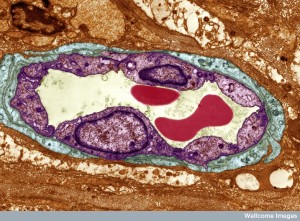 This dramatic recent discovery could alter treatment for many diseases including cancer, where new blood supply has long been considered critical. Special capillary cells that line the tiniest blood vessels in each tissue are vitally involved in regulating special stem cells in each region that produce the cells for the tissue in normal development, maintenance and repair.
This dramatic recent discovery could alter treatment for many diseases including cancer, where new blood supply has long been considered critical. Special capillary cells that line the tiniest blood vessels in each tissue are vitally involved in regulating special stem cells in each region that produce the cells for the tissue in normal development, maintenance and repair.
Capillaries Do More Than Deliver Blood
 The lining cells of the smallest capillaries are not just delivering blood. These lining endothelial cells are involved in secreting multiple factors specific for the tissues where they lie. These signals are related to the form and function of the organ and are vital in regeneration of specific tissue. Capillary communication is, also, vital for maintenances of normal metabolism and tissue functioning. When an organ needs to regrow, capillaries become vital partners in all aspects of growth including orchestrating the production particular stem cells.
The lining cells of the smallest capillaries are not just delivering blood. These lining endothelial cells are involved in secreting multiple factors specific for the tissues where they lie. These signals are related to the form and function of the organ and are vital in regeneration of specific tissue. Capillary communication is, also, vital for maintenances of normal metabolism and tissue functioning. When an organ needs to regrow, capillaries become vital partners in all aspects of growth including orchestrating the production particular stem cells.
Capillary beds are vital parts of tissue where blood is closest to the cells and where oxygen and nutrients are delivered. They connect the larger arteries and veins and have their own special vascular beds. They transport immune cells into the tissue and regulate blood coagulation. They are highly involved in metabolism. These capillary cells work with stem cells to avoid fibrosis and scarring when rebuilding tissue. Capillary cells work and communicate in teams with many other cells including stem cells for blood cells, tissue cells and neurons. They signal to each of these stem cells with particular factors that either stimulate or inhibit their activities. They send cytokines and attractive chemokine signals to bring particular types of immune cells to tissues and they build special extracellular matrix near the capillary with the unique properties needed in the tissues. These activities of capillaries secreting signals are called angiocrine.
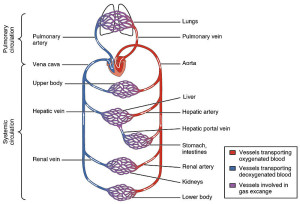
Capillaries determine whether stem cells become active or stay quiet. It was previously known that capillary vessels are critical for the unique development in the fetus of the pancreas and the liver. It has been known that blood vessels are critical for unknown reasons for cancer spread. But the extent of their back and forth communication for, development, maintenance of tissues and avoidance of scars during regeneration is just know being discovered.
Instructions from Capillary Lining Cells
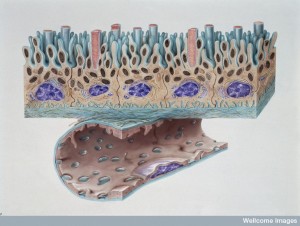 There are 10 to 50 trillion single lining capillary cells in the human body. Capillaries make up 95% of the total surface area of all blood vessels that extend into every region of the body. The lymph systems are independent, open and parallel to these blood vessels.
There are 10 to 50 trillion single lining capillary cells in the human body. Capillaries make up 95% of the total surface area of all blood vessels that extend into every region of the body. The lymph systems are independent, open and parallel to these blood vessels.
Stem cells for the particular tissues sit very near the capillary cells and can receive their signals easily. The capillary cells are able to use the blood vessels to send signals to distant immune cells. The stimulation goes both ways with the tissue cells activating the capillary cells when it is necessary to build some new tissue. Capillaries produce many critical factors such as vascular endothelial growth factor (VEGF), fibroblast growth factor (FGF), stromal cell derived factor (SDF), thrombospondin and many others. Capillary cells work independently of the pericytes and tissue cells to integrate many different signals.
New Blood Vessels
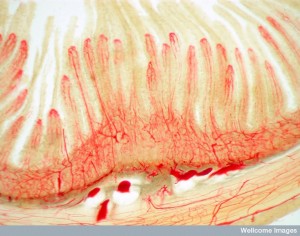 New blood vessels are needed in all new tissue and are vital for the survival of organs. Capillary cells regulate the entire tissue by maintaining the amount of blood vessels necessary through this complex communication. When specific damage is done to organs through radiation, chemicals or lack of oxygen, it is the capillary cells that respond with the necessary signals. They call for special immune cells and cytokines.
New blood vessels are needed in all new tissue and are vital for the survival of organs. Capillary cells regulate the entire tissue by maintaining the amount of blood vessels necessary through this complex communication. When specific damage is done to organs through radiation, chemicals or lack of oxygen, it is the capillary cells that respond with the necessary signals. They call for special immune cells and cytokines.
Some factors secreted by capillaries are morphogens, determining the shape and size of the increased tissue (See post on how cells know how to grow 3D shape and size of organs). Each tissue’s capillaries are unique in their stimulating factors for the particular organ. Some of the factors stimulate an entire cluster of other factors such as VEGF-A, which produces a large group of other factors.
Capillaries Stimulate Neuron Stem Cells in the Brain
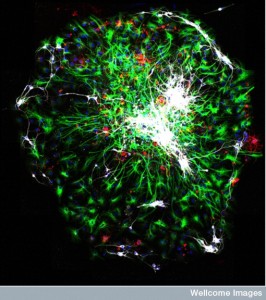 In the adult brain, new neurons continue to be made in particular regions for memory, mainly in the subventricular zone (SVZ) and subgranular zone (SGZ) in the dentate nucleus of the hippocampus. The stem cells that make the new neurons are right next to the capillary cells that have receptors for VEGF and multiple other factors. In fact, the stem cells have particular end feet that sit on the capillary cells.
In the adult brain, new neurons continue to be made in particular regions for memory, mainly in the subventricular zone (SVZ) and subgranular zone (SGZ) in the dentate nucleus of the hippocampus. The stem cells that make the new neurons are right next to the capillary cells that have receptors for VEGF and multiple other factors. In fact, the stem cells have particular end feet that sit on the capillary cells.
There are many other places where capillary cells stimulate neurons from stem cells. Capillary cells in the umbilical cord produce BDNF a primary neural stimulating factor. Those in the pulmonary artery drive factors of neuron stem cells. The capillary cells have factors that maintain the stem cell quiet state and those that stimulate activity. Even at the choroid plexus, the capillary cells regulate quiet and active neural stem cells.
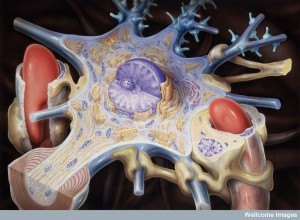 When tissue is needed to regenerate, capillary cells vastly increase their repertoire of signals to include BDNF, PEDF, betacellulin, PIGF and many other factors. These stimulate neural stem cells that travel where needed and make more cells. These signals in blood vessels that travel along with the “rostral migratory stream” maintain the migration of new stem cells into the olfactory bulb. They secrete these factors into the cerebrospinal fluid as well altering the activity in the entire brain. There is complex crosstalk between the capillary cells and the neurons to regulate the growth of these new neural structures. This increases when there is brain injury from too little oxygen.
When tissue is needed to regenerate, capillary cells vastly increase their repertoire of signals to include BDNF, PEDF, betacellulin, PIGF and many other factors. These stimulate neural stem cells that travel where needed and make more cells. These signals in blood vessels that travel along with the “rostral migratory stream” maintain the migration of new stem cells into the olfactory bulb. They secrete these factors into the cerebrospinal fluid as well altering the activity in the entire brain. There is complex crosstalk between the capillary cells and the neurons to regulate the growth of these new neural structures. This increases when there is brain injury from too little oxygen.
In the brain there are three levels of support from the capillary cell. The first is stimulating stem cells to differentiate into particular types of progenitor cells with particular signals such as NT-3. Then stimulating the progenitor cells to migrate and to create specific brain cells with PEDF, VEGF, and PIGF signals. Third, stimulating the function of the brain cells with BDNF, nitric oxide and other signals.
Capillaries Stimulate Sperm Stem Cells
Stem cells for sperm, also, sit near the interstitial capillary cells in the seminiferous tubules of the testes. Signals from the capillaries makes the stem cells operate.
Capillaries Regulate Stem Cells for Blood Cells
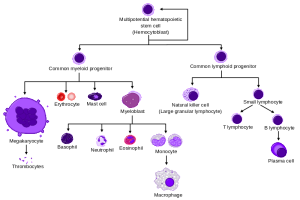
The capillary cells in the bone marrow have many unique properties. They support both the stem cells in the bone marrow that make all of the many different progenitor cells for each type blood cell, but, also, stimulate in a different way the particular progenitor cells for particular blood cells. There are a wide range of complex signals that the capillary cells use to stimulate and inhibit the creation of the necessary different blood cells. The capillary cells sit in the sinusoidal region of the bone marrow.
Capillaries drive two levels of stem cells, both the original multi purpose stem cells and then the progenitor cells for each cell type. This involves secreting interleukin 6 and 8, granulocyte stimulating factor GCSF, Il-1, tumor necrosis factor (TNF), many chemokines, and metalloproteinases. They both stimulate and inhibit activity. There are a host of other factors from capillary cells such as prostaglandin E2, peliotrophin and epidermal growth factor (EGF) that can re establish the reservoir of the bone marrow to regenerate.
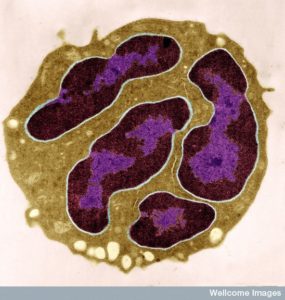 When bone marrow is depleted, the capillary cells produce a uniquely orchestrated set of signals. There are a large number of signals producing cascades to both stop full exhaustion of the stem cells, but also to start replenishing the stores of vital blood cells. These signals produced very elaborate cascades involving many kinases and other enzyme activity. One particular macrophage colony stimulating factor (M-CSF) increases the stem cells for myeloid blood cells and for T and B lymphocytes. When the new cells are being produced, they send factors to inhibit too much production. Some of these studies were done on bone marrow that was destroyed with radiation. These same factors are present during normal function to a lesser degree.
When bone marrow is depleted, the capillary cells produce a uniquely orchestrated set of signals. There are a large number of signals producing cascades to both stop full exhaustion of the stem cells, but also to start replenishing the stores of vital blood cells. These signals produced very elaborate cascades involving many kinases and other enzyme activity. One particular macrophage colony stimulating factor (M-CSF) increases the stem cells for myeloid blood cells and for T and B lymphocytes. When the new cells are being produced, they send factors to inhibit too much production. Some of these studies were done on bone marrow that was destroyed with radiation. These same factors are present during normal function to a lesser degree.
One complication is that the perivascular cells (the cells that sit just outside of the capillary endothelial cells) also produce factors. Recent studies show that the factors from the capillary cells are the prominent directors of the entire process. In particular, capillary cells in special sinusoid niches have the most authority to direct the reconstitution of the damaged bone marrow.
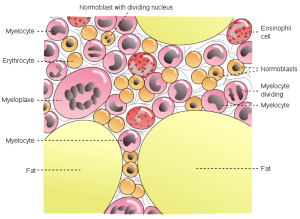 Studies show that not all capillary cells can do this. Each type of tissue has unique vascular beds that have the unique ability to stimulate that type of tissue and many of these lie in unique types of structures like sinusoids. In the fetus, the particular lines of capillary cells are developed for each structure and for the development of the very special ones who can replenish the bone marrow. In fact, some capillary cells can serve as stem cells themselves for particular blood cells in certain circumstances. Studies showed that a group of particular transcription factors FosB, Gfi1, Runx1 and Spi1 (collectively termed FGRS) stimulate this transformation. But, even after this transformation, these new cells still need directions from the capillary cells. These studies show that capillary cells are involved in the stimulation of blood stem cells, their maintenances under normal circumstances and their repopulation after disasters.
Studies show that not all capillary cells can do this. Each type of tissue has unique vascular beds that have the unique ability to stimulate that type of tissue and many of these lie in unique types of structures like sinusoids. In the fetus, the particular lines of capillary cells are developed for each structure and for the development of the very special ones who can replenish the bone marrow. In fact, some capillary cells can serve as stem cells themselves for particular blood cells in certain circumstances. Studies showed that a group of particular transcription factors FosB, Gfi1, Runx1 and Spi1 (collectively termed FGRS) stimulate this transformation. But, even after this transformation, these new cells still need directions from the capillary cells. These studies show that capillary cells are involved in the stimulation of blood stem cells, their maintenances under normal circumstances and their repopulation after disasters.
In bone marrow, there are three levels of stimulation from capillary cells, as in brain cells. The first is to renew the stem cells that sit near the capillaries with signals such as SDF, PGE Kit ligand, Wnt, Noggin, TGF, etc. Then, there are signals to differentiate into particular progenitor cells (that is particular stem cells for specific blood cells) with signals IL-6, GM-CSF, M-CSF, G-CSF and MAPK and AKT activation. Third, there is stimulation to make specific megakaroyote cells for platelets, myeloid cells for white cells and lymphoid cells.
Capillary Cells and Bone
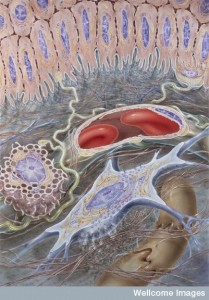 Bones are remodeled constantly, but stay in equilibrium with the amount of blood cells. There is a constant dynamic of stimulating and inhibition. Surprisingly, it is the capillaries that actually regulate this process.
Bones are remodeled constantly, but stay in equilibrium with the amount of blood cells. There is a constant dynamic of stimulating and inhibition. Surprisingly, it is the capillaries that actually regulate this process.
The arteries and sinusoidal vessels give guidance for the amount of blood cells, while special capillary cells (type H and L) regulate the amount of bone to be made. Type H stimulates osteoblasts (new bone cells and chondrocytes). Type L creates specific sinusoidal vessels near the bone marrow. The many stimulating and inhibitory signals keep the space for the bone and the blood in balance.
Capillary Cells Regulate Liver Cells
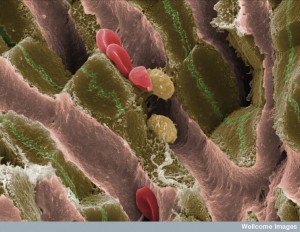 Special capillary cells in sinusoidal vessels in the liver keep the balance between flow in the hepatic artery and vein and the portal vein. Special capillary cells in the liver become fenestrated without a basement membrane and stimulate a very large amount of signals—CD34, VEGFR 1,2,3, VE-cadherine, CXCR7, CD31, VII, stabilikn, CD32b, CD209L, just to mention a few. These capillary cells orchestrate replacement of liver cells that are damaged by fibrosis. These new cells sit near the capillaries in the central vein.
Special capillary cells in sinusoidal vessels in the liver keep the balance between flow in the hepatic artery and vein and the portal vein. Special capillary cells in the liver become fenestrated without a basement membrane and stimulate a very large amount of signals—CD34, VEGFR 1,2,3, VE-cadherine, CXCR7, CD31, VII, stabilikn, CD32b, CD209L, just to mention a few. These capillary cells orchestrate replacement of liver cells that are damaged by fibrosis. These new cells sit near the capillaries in the central vein.
When 70% of the liver is cut out, the liver that remains grows new cells. It is the capillary cells that orchestrate the growth of these cells with a wide range of signals. They make new vessels to help bring nutrients to the new liver cells. The capillary cells somehow know how large the a liver should be and only stimulate the growth of that amount of cells.
When the liver is incapable of re growing normally, an abnormal fibrosis fills the space. It is again the capillary cells that guide both of these processes. When an acute injury occurs, the capillaries stimulate normal cells without fibrosis. But, when chronic, constant destruction occurs through excessive alcohol and very abnormal metabolism syndrome effects, then particular signals occur that leads to the other pathway of fibrosis. The capillaries orchestrate both the normal and abnormal liver growth.
Capillaries Stimulate Lung Cells
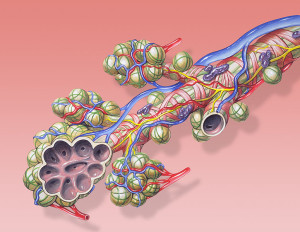
The lungs have unique capillaries that are interwoven with the alveolar cells where oxygen from the blood comes in very close contact with the air spaces. There is a special membrane between the capillary cell and the alveolar cells for the gas exchange. There is a great amount of back and forth discussion between these two cells in the form of many different types of signals CD31, CD34, FGF, VEGFR 1,2, CD45 and more.
As in other tissues, capillary cells are vital for the growth of new lung cells. When a piece of lung is surgically removed, stem cells for the alveolar epithelial cells make progenitor cells and then alveolar cells. Again it is elaborate signaling from the capillary cell that directs this process using multiple different special lung stem cells. Special pulmonary basal cells are one type of cell that is produced.
Capillary Cells Direct the Pancreas
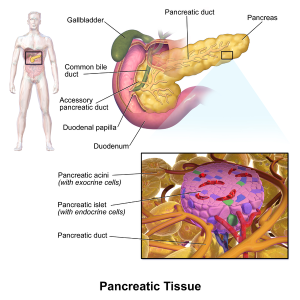
Capillary cells near the islet cells of the pancreas that make insulin are in communication about metabolism. If the islet cells are acutely damaged, then capillary signals stimulate regeneration of the pancreas to bring sugar metabolism back to normal. This occurs, also, through many elaborate signals (including TGF-beta1, TSP-1, EGFL7 and more). In fact, in this very complex process some special capillaries even become fat cells to remodel the fat tissues. The capillary cells can affect metabolism directly with other special signals. They stimulate fat stem cells.
Capillaries Directing Muscles
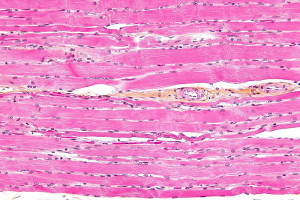
Stem cells for muscles are also in close contact with capillary cells. There are a group of very specific signals that capillaries send to stimulate striated muscle productions (IGF1, HGF, FGF-2, PDGF-BB and many others).
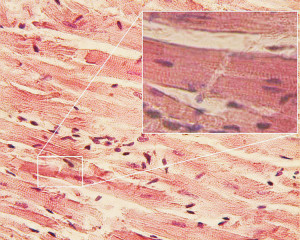
Cardiac muscles are surrounded by their own unique capillary cells. The critical strength of the beating of the heart is regulated and stimulated by capillary factors including neuregulin-1, endothelin-1, nitric oxide and others. Neuregulin-1 is secreted when the capillaries sense low oxygen pressure. When the heart muscle is damaged by too little oxygen (ischemic injury), then capillaries swing into higher gear and stimulate repair of the heart muscle and stimulate increases in contraction strength of the existing muscles.
Capillaries Determine Organ Shape with Morphogens
A previous post asked how cells know exactly how large the organ should be. The complex signaling involves capilalries calling the exact cells to particular locations and then helping them rebuild the exact pattern that is necessary such as the special structures for the lungs, the brain and the liver. The capillaries stimulate enough stem cells to fulfill the size requirements as well. The capillary bed enlarges to meet the needs.
Unique Capillary Structures
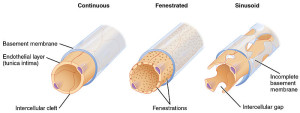
It is not yet clear how the capillaries know to produce particular structures such as fenestrations that are needed for particular secretions. In unique regions, some triggers are known, such as progesterone in the uterus. The various regional capillary cells are able to trigger specific genetic networks in unique ways. Complex back and forth communication with the tissue cells is not yet worked out and may be part of the way the capillary cells produce their specific tissue specific factors.
The current research has been related to the very new notion that particular secreted signals from capillaries are critical for stem cells in tissues. Even more research has begun to find out other ways that capillary cells use exosomes for communication (see post on exosomes) and the particular ways they build the extracellular matrix (see post on extra cellular matrix ).
In each tissue, a variety of particular structures are built and unique forms of capillaries appears. In the liver there are specialized sinusoids that are fenestrated and are right next to the liver cells. In bone marrow, the capillary cells are directly connected with the stem cells. In the lungs, capillary cells are right next to the alveolar epithelial cells, without fenestration. In brain, capillaries are right near the stem cells.
Intelligent Capillary Cells Regulate Tissue Stem Cells
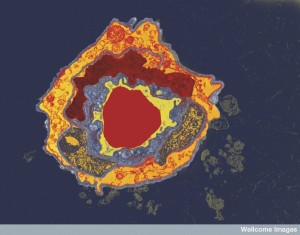 Everywhere we look in the body, cells are talking to each other and making critical decisions with back and forth signals of all types. Neurons use neurotransmitters, cytokines, electrical synapses, and electrical brain waves to communicate with other neurons, glial cells and immune cells. All types of immune cells use very complex cytokine signaling to make critical decisions in the fight against microbes. Both use vesicles and nanotubes with vital information in the form of genetic material, proteins and other factors. The cells that line the intestine, the skin and the cerebrospinal fluid are especially intelligent regulating communication with a vast amount of different microbes and cells. Even the lowly platelet, not considered a full cell, has a vast repertoire of communication.
Everywhere we look in the body, cells are talking to each other and making critical decisions with back and forth signals of all types. Neurons use neurotransmitters, cytokines, electrical synapses, and electrical brain waves to communicate with other neurons, glial cells and immune cells. All types of immune cells use very complex cytokine signaling to make critical decisions in the fight against microbes. Both use vesicles and nanotubes with vital information in the form of genetic material, proteins and other factors. The cells that line the intestine, the skin and the cerebrospinal fluid are especially intelligent regulating communication with a vast amount of different microbes and cells. Even the lowly platelet, not considered a full cell, has a vast repertoire of communication.
Perhaps, the most important discovery of all is that capillary cells do a lot more than funnel blood, oxygen and nutrients to every corner of the body. Capillary cells are now found to be vital brains of tissues, stimulating, regulating, maintaining and inhibiting very unique stem cells for each organ. Blood vessel cells are, also, vital for the growth and spread of cancer and other diseases.
It is interesting that Aristotle, who invented the science of biology, believed blood vessels direct organs and he is now found to have been correct.
Where is the regulation for this fantastic intelligent behavior of unique capillary cells in all organs? The direction for this has to span the entire body. How can anyone think this is random? A reasonable view of how this intelligence could exist in each cell is that mind interacts with all of cells and molecules.